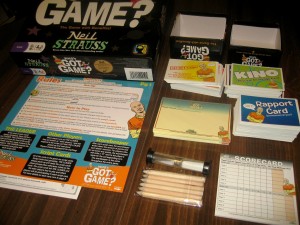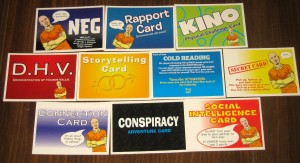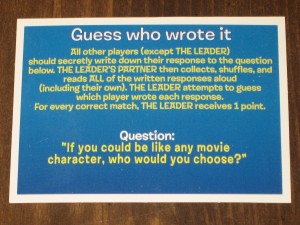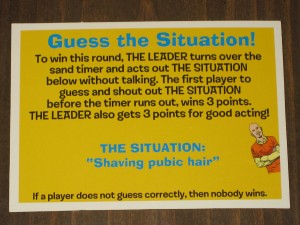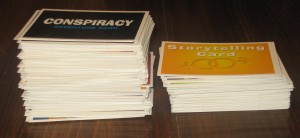Let’s pretend for a moment that you’re hosting a party and that the guests of honor should be arriving any minute. You’ve got your Star Trek DVDs locked and loaded, you’ve got your favorite Hanson album blasting away, and the eighteen topping pizzas that someone is sure to be allergic to are on their way. You’re confident that Captain Kirk can keep your guests actively engaged throughout the evening, but you’re thinking of bringing out a party game just to be sure.
In all seriousness, how often has this happened to you, ”in an mmmbop they’re gone” aside? Trying to find an activity that all of your guests will enjoy can be a difficult thing to do. It can also be nerve-wracking if you happen to have your eye on a special someone and don’t want to appear boring.
People often associate party games with common names like “Scene It”, “Pictionary”, “Outburst”, and “Apples to Apples”, however you may be surprised to learn just how many party games lie beyond the comfortable nest that you and your regular group have dug yourselves into. I’m here today to take a look at one such example, titled “Who’s Got Game?”
Before we get started, I wanted to extend a quick thank you to Adam Kornblum (the co-creator of “Who’s Got Game?”) for reaching out to me and sending me a free copy to review. He was extremely polite and helpful in answering all of my questions.
“Who’s Got Game?” was developed by seven-time New York Times best-selling author Neil Strauss and game developer Adam Kornblum. The main inspiration behind this game was based off of Neil’s books, “The Game” and “Rules of the Game”, just to name a few. Adam wanted to create a game that encouraged people to overcome the fear of getting to know new people, and after both parties collaborated, “Who’s Got Game?” was born.
Just as a quick overview on what this game is about, players will be taking turns drawing cards and socially interacting in various ways in an attempt to score the most points. Let’s take a quick look at the components, setup, and gameplay before heading into the review.
Components
Script Cards – These cards are the meat and potatoes of the game and come in various forms. Some cards might require players to perform physical challenges while other cards might task players with acting or public speaking.
Scorecard – This serves as a way for players to keep track of their points during a game. Ideally, one person should be assigned as the scorekeeper.
Notepad and Pencil – Each player will be given one at the beginning of the game, to use as required by whatever script cards that they may draw.
Sand timer – A timer that is used as needed throughout the game and during the “Final Challenge.”
Setup
Setting up the game is fairly easy and consists of the following:
1. Shuffle the script cards and place them into the script card holder.
2. Choose a scorekeeper and give everyone a pencil and notepad.
3. Choose a permanent partner that you will be tasked with interacting with throughout the game. Give your partner a unique nickname. Everyone else will be doing the same.
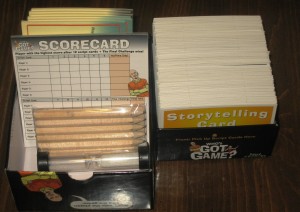
The game comes with two boxes of different sizes to help players organize the components during play.
Gameplay
Throughout the game, players will be known as “The Leader”, depending on who’s turn it currently is. The scorekeeper begins the game as The Leader.
The Leader picks up a script card from the holder and reads it aloud. The script card will instruct everyone playing on what to do…tasks will vary from card to card. Once the task on the card is completed, the scorekeeper will give the appropriate players points, based on what the card instructed them to do and how successful they were in completing them.
Afterward, the next person clockwise will become The Leader, pick up a card, and the process repeats. After a set number of script cards have been played, each player must complete “The Final Challenge.”
The Final Challenge is the same every game. The sand timer is flipped and each player must write down one thing that each other player had said during the game. Each player gets one point per accurate statement.
The scorekeeper then must tally all of the points that players have earned throughout the game and during The Final Challenge. The person who has the most points at the end of it all wins!
The Review
First, I’d like to touch on how easy the game is to pick up and play. There aren’t that many components, but having a boatload of pieces doesn’t always make for a great game. Sometimes, all people want to do is play something quick and easy as opposed to losing an entire weekend to Risk.
I also want to mention that I like how the script cards have ten different types of categories. Let’s face it, some of us aren’t as social as others and some of us aren’t as comfortable in revealing our personal pleasures when in a group setting (sorry, I’m old-fashioned). Uncomfortable with massaging your partner as the script card tasks you to do? Draw a new card! Giving players a variety of ways to interact allows the game to be customizable to suit a particular group’s needs or wishes.
Creative minds can have a lot of fun with the script cards without keeping score. You could take the script cards out to a social gathering (public or private) and just use the cards as an activity to help pass the time. I remember, as a kid, frequenting a particular Pizza Hut that had trivia cards at every table…and I had a really good time. The potential for creating a particular “deck” of script cards to match a particular situation is endless.
Overall, ”Who’s Got Game?” is a fantastic party game that has a lot to offer. Playing the game with your kids and family is possible, but this game is ideally meant for an adult group setting. You’ll get the most bang for your buck by keeping the audience over eighteen years of age. If your kids do express an interest in trying it, I found that the best way to make this game family friendly is to go through the cards ahead of time and exclude the more raunchier ones.
The family and I played a full game (excluding the inappropriate and more difficult cards) and things went very well. We actually sat around for an hour afterwards, playing out the actions on the Storytelling cards and analyzing personality types on the Cold Reading cards without keeping score. I really liked how the cards were open enough to allow younger audiences to answer in a silly manner, much like we do when playing “Say Anything!” or “Apples to Apples.”
Jennifer, my girlfriend, mentioned that this game would be “a hoot” to play for when her brother and sister came over with their significant others. Her thoughts on the game paralleled with mine in that playing the game with kids is very possible, but it would be better with a group of adults…the more the better. Regardless, the kids had a blast and didn’t want to stop playing.
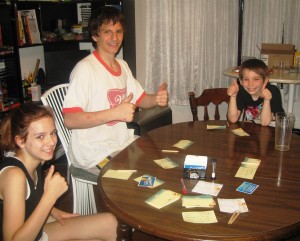
Play of the Evening: “If you got to ask a higher power one question, what would it be?” Anthony Jr: “Should I bring out Pikachu, Squirtle, or Bulbasaur?”
If you’re in the market for a new party game, give “Who’s Got Game?” a look!
Final Verdict: 7/10
—
You can learn more about the game on the official website and on Board Game Geek here:
Who’s Got Game? – Official Website
The scorecards that come with the game are for the four to six player game. You can find and print scorecards for the eight to twelve player game here:
Who’s Got Game – 8 to 12 Player Scorecard
—

